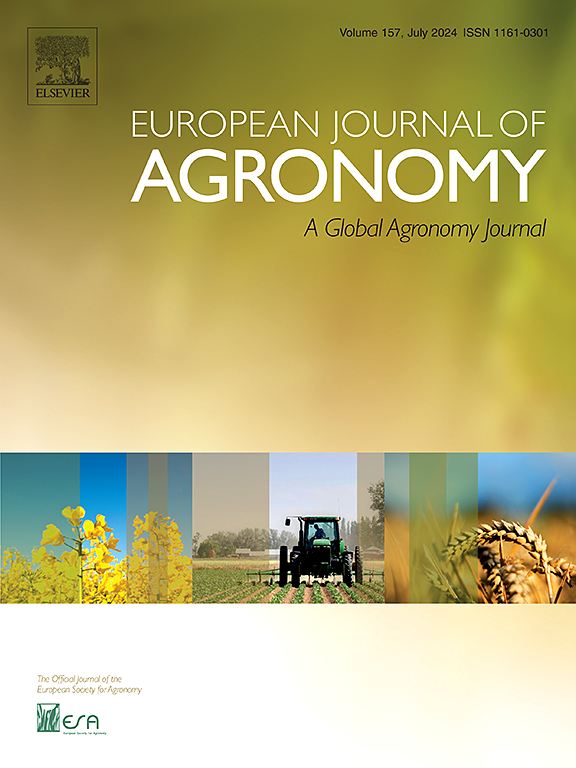作物模型校正的贝叶斯框架:以美国玉米带为例
IF 5.5
1区 农林科学
Q1 AGRONOMY
引用次数: 0
摘要
作物模型在模拟作物生长、预测产量和评估改善生产的干预措施方面发挥着关键作用。然而,它们的可靠性经常受到参数化、土壤性质、管理实践和气象输入的不确定性的阻碍。这些不确定性会显著影响模型的准确性,特别是当模型应用于不同的作物、品种或田地时。本研究使用APSIM作物模型在不同的天气条件、土壤类型和多个生产年份的管理实践下探索了这些概念,但重点是一个地点。我们的分析集中在内布拉斯加州林肯附近的三个研究领域,在单种或轮作作物配置下种植不同的玉米品种,并在雨养和灌溉制度下种植。首先,我们进行了全球敏感性分析,以评估品种参数的变化如何影响关键模型输出:叶面积指数、生物量和产量。我们通过进行季节内敏感性分析来跟踪参数在生长周期中的时间影响,从而推进分析。使用基于mcmc的贝叶斯推理方法,我们估计了最具影响力的参数。结果表明,在这个特定的地理位置和农艺条件下,超过50% %(13个品种中的7个)的品种参数对模型输出的影响最大,其中最敏感的参数根据所调查的模型输出而变化。值得注意的是,早期捕获辐射所涉及的参数在所有领域和产出中影响最大。季内敏感性分析显示,不同作物物候阶段的参数敏感性不同,这表明在季节的特定窗口内有针对性的参数校准的潜力。在实际案例中使用MCMC的校准模型在预测和观测输出之间提供了很强的一致性,R2值范围为0.84至0.98,相对RMSE在10 %至34 %之间。与未校准的模型相比,校准后的模型表现出更好的性能,RMSE值至少降低了30 %,并且与原位测量的相关性增强。这些发现证实了贝叶斯校准方法的稳健性及其准确预测不同季节和不同玉米品种作物发育的能力。因此,这种方法提供了一种有价值的工具,用于校准作物模型,同时量化与输入参数相关的不确定性。将这一分析和模型扩展到更大的区域将检验其是否适合在规模上更广泛地应用模型。本文章由计算机程序翻译,如有差异,请以英文原文为准。
A Bayesian framework for crop model calibration: A case study in the US Corn Belt
Crop models play a key role in simulating crop growth, predicting yield, and assessing interventions for improving production. Nevertheless, their reliability is often hindered by uncertainties in parameterization, soil properties, management practices, and meteorological inputs. These uncertainties can significantly affect model accuracy, especially when models are applied to different crops, cultivars, or fields. This study explores these concepts using the APSIM crop model under varying weather conditions, soil types, and management practices across multiple production years, but with a focus on a single location. Our analysis focuses on three research fields near Lincoln, Nebraska, growing different maize cultivars in either mono-cropping or rotational-crop configurations, and under both rain-fed and irrigated regimes. Initially, we perform a global sensitivity analysis to assess how variations in cultivar parameters affect key model outputs: leaf area index, biomass, and yield. We advance the analysis by conducting an intra-season sensitivity analysis to track the temporal impact of parameters over the growing cycle. Using an MCMC-based Bayesian inference approach, we estimate the most influential parameters. Results indicate that, for this specific location and agronomy, over 50 % (7 out of 13) of cultivar parameters have the greatest impact on model outputs, with the most sensitive parameters varying depending on the model output under investigation. Notably, parameters involved in the early capture of radiation were the most influential across all fields and outputs. The intra-season sensitivity analysis reveals that parameter sensitivity varies across different crop phenological stages, suggesting the potential for a targeted parameter calibration within specific windows of the season. The calibrated model using MCMC in a real-world case scenario delivers a strong agreement between predicted and observed outputs, with R2 values ranging from 0.84 to 0.98, and relative RMSE between 10 % and 34 %. Compared to its uncalibrated counterpart, the calibrated model exhibits improved performance, with at least a 30 % reduction in RMSE values and enhanced correlation with in situ measurements. These findings confirm the robustness of the Bayesian calibration approach and its ability to accurately predict crop development across multiple seasons and maize cultivars. As such, this approach provides a valuable tool for calibrating crop models while simultaneously quantifying the uncertainty associated with input parameters. Extension of this analysis and model to larger regional areas would test its suitability for more generalized application of models at scale.
求助全文
通过发布文献求助,成功后即可免费获取论文全文。
去求助
来源期刊

European Journal of Agronomy
农林科学-农艺学
CiteScore
8.30
自引率
7.70%
发文量
187
审稿时长
4.5 months
期刊介绍:
The European Journal of Agronomy, the official journal of the European Society for Agronomy, publishes original research papers reporting experimental and theoretical contributions to field-based agronomy and crop science. The journal will consider research at the field level for agricultural, horticultural and tree crops, that uses comprehensive and explanatory approaches. The EJA covers the following topics:
crop physiology
crop production and management including irrigation, fertilization and soil management
agroclimatology and modelling
plant-soil relationships
crop quality and post-harvest physiology
farming and cropping systems
agroecosystems and the environment
crop-weed interactions and management
organic farming
horticultural crops
papers from the European Society for Agronomy bi-annual meetings
In determining the suitability of submitted articles for publication, particular scrutiny is placed on the degree of novelty and significance of the research and the extent to which it adds to existing knowledge in agronomy.
 求助内容:
求助内容: 应助结果提醒方式:
应助结果提醒方式:


